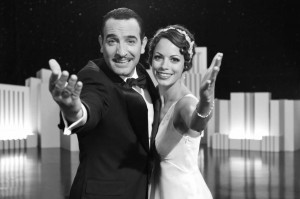
The Artist is an endlessly charming film dizzy with expressive, lovely imagery. Michel Hazanavicius (writer/director/editor) commanded an impressive team to create the dazzling spectacle of a world filled with silks, furs, Marcel waves, and bold lipstick: costume designer Mark Bridges, makeup artist Julie Hewett, and hair stylist Cydney Cornell.
The story of declining matinee idol George Valentin (Jean Dujardin) meeting aspiring actress Peppy Miller (Berenice Bejo) is chronicled in the black-and-white silent film that charms in a manner that harkens back to a more elegant era where appearances defined everything. The film plays like a dream.
The year is 1927 and the debonair Valentin is bewitched by Peppy Miller, a young ambitious flapper featured as a dancing extra in his film. It’s still the height of Valentin’s fame and Peppy is equally enchanted with the astonishingly handsome movie star resplendent in his trademark tuxedo with tails. At a private encounter in his dressing room, Valentin admires Peppy’s face, an ambrosia of thin penciled eyebrows, wide eyes contoured with shadow and draped by lush lashes. Valentin gazes at Peppy and says, “If you want to be an actress, you need to have something the others don’t.” With the flourish of an eyeliner, he paints a beauty mark above her carefully drawn in lips.
Valentin scoffs at the development of sound, and when talkies arrive, his career which was built on silent swashbucklers abruptly plummets. “George Valentin is a composite of John Gilbert and Douglas Fairbanks,” says costume designer Mark Bridges. When Valentin is playing Zorro, he seems to have been inserted directly into the original swashbuckling silent film star of Fairbanks’s films. Sirens of the golden screen inspired Bridges when it came to building Miller’s look too. “When we were searching high and low in costume houses, we found Dorothy Lamour’s boots from Paramount,” Bridges said. He bought the boots, even though Miller hadn’t been cast yet, and there were no guarantees that the boots would fit the actress who would be hired for the role. When the part went to Berenice Bejo, the most serendipitous moment occurred when the boots fit the actress perfectly.
As Valentin’s career descends, he abandons his perfectly tailored suits and lacquered patent shoes. As the identity Valentin carved out for himself is lost, he sells his wardrobe. He trades his luxurious brocade robes for a simple unadorned robe. Even his face, which resembled John Gilbert at his most dashing, with his side parted glossy hair, the thin neat mustache and immaculately arched eyebrows, becomes disheveled and displaced as the stardom he once knew spirals farther out of his trajectory.
As Peppy’s star ascends, she is draped in opulent furs, sequined dresses, and veiled cloches, much like Joan Crawford. Peppy’s transformation is inspired by the original flapper girl on the street who turned into a glamorous star. Her short waves are fitting for her hair but are harder to pin down onto one particular starlet from Hollywood’s golden era. “[Her hair] is a combination of everyone because we were working with a particular actress and we were going for authenticity. We did tests. We did Louise Brooks at one point, it was sort of chiseling away till we got there,” said hair stylist Cydney Cornell. The team certainly perfected the look of every character in this witty, sly, tender adventure of a film. When the story unfolds to its dramatic end, Valentin and Peppy appear to be exactly who they were meant to be.
For more information about the BTL Screening Series, visit: http://screenings.btlnews.com/





